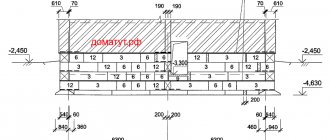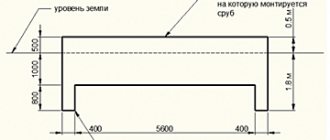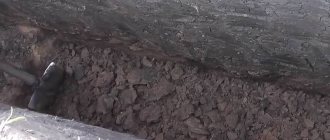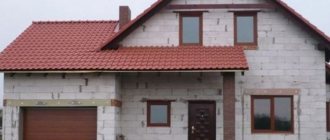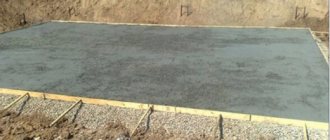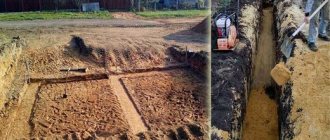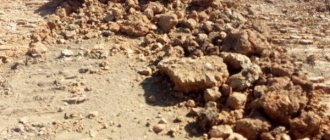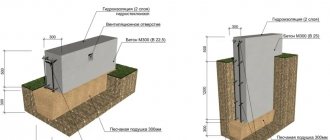Beton-House.com
Website about concrete: construction, characteristics, design. We combine the experience of professionals and private craftsmen in one place
Prefabricated strip reinforced concrete foundation
A strip prefabricated reinforced concrete foundation is a single continuous concrete structure for the base of a house, consisting of the following components - foundation blocks (FBS) GOST 13579 78 and reinforced concrete strip foundation slabs GOST 13580 85 (FL).
All reinforced concrete products necessary for the construction of this type of foundation are mass-produced in the factory, so a strip foundation made of precast reinforced concrete is always strong, has good performance characteristics and is durable (see video in this article).
- Cutting off plant soil and marking the axes of the future building
- Installation of reinforced concrete foundation slabs
Work quality control
| Parameter | Parameter value, cm | Control (method, volume, type of registration) |
| Deviation of the actual dimensions and position of on-site (and prefabricated) foundations and grillages from the design ones, see: | ±5 (±2) | Acceptance (measurements with theodolite, tape and ruler) |
| dimensions in terms of | +2; -0,5 | Same |
| protective layer thickness | (+1; -0,5) | Same |
| height position of the top (edge) of the foundation or grillage | ±2 (±1) | Same |
| plan positions relative to alignment axes | 2,5 (1) | Same |
| Note - The values given in the table in brackets refer to prefabricated foundations and grillages. |
Download series 2.110-1 “Details of foundations of residential buildings” issue 1 Download series 2.110-1 “Details of foundations of residential buildings” issue 4
Advantages and disadvantages of FBS blocks
Foundation blocks are brought to the construction site in a form completely ready for work. You just need to lay out the masonry from them. There is no need to wait for the concrete to set and gain strength. In terms of speed of construction, such a foundation for a private house can only be surpassed by a foundation on stilts. It is generally difficult to compete with this option.
The choice of FBS device is often determined by minimizing time costs. Plus, its construction can be carried out even in winter. However, this comes at the cost of having to use lifting equipment. It is impossible to manually lay the products into the foundation; they are too heavy. As a result, this option is 15–25% more expensive than its analogue in the form of a monolithic tape.
A crane is required for lifting
The main thing is that when compared with a monolith, the block type of foundations for buildings is somewhat inferior in terms of load-bearing capacity. And while it can easily withstand high vertical loads, there are serious problems with horizontal ones. If there is severe heaving, the block can simply be squeezed out of the supporting structure.
Design and drawings
When choosing the type of strip base, experts take into account many factors, including the following nuances:
- The degree of soil freezing.
- Load level from the future building.
- Height of groundwater location.
- "Ribbon" design.
- Seismic activity in the location chosen for construction.
- Relief features.
- Soil composition, properties of individual layers.
The slightest errors in calculations are fraught with serious consequences, from distortions during the shrinkage of the building to premature destruction of the integrity of the foundation and the structure itself.
The design drawing is included in the documentation for the entire building. You can see what different installation schemes for foundation blocks look like in the illustrations below.
How to make a foundation from FBS blocks
And also when it is planned to build a panel house.
A columnar foundation is also well suited for wooden houses.
Strip foundations are used mainly when constructing light, low-rise buildings; this solution is also ideal for building a country house made of wood. You should not use FBS blocks as a material for a strip foundation if there will be heavy loads on it.
Before erecting a strip foundation, it is imperative to make a filter pad; it is made of two layers - sand (5 centimeters thick) and crushed stone (10 centimeters). After laying these layers, they are thoroughly compacted, spilled with water and compacted again.
It is best to use cushion blocks on the lowest row of the foundation; if this is not possible, then for the first row the products are placed on their sides. Work on the beginning of the construction of the foundation begins from the place where the walls and corners intersect. Then the correctness of the first row of the horizon must be checked.
When working with a columnar foundation, it is also necessary to create a pre-filter pad. To make it, first lay a 15-centimeter layer of crushed stone, and then a 10-centimeter layer of white gravel.
It is also necessary to achieve the maximum density of the pillows in order to avoid distortions of the blocks installed on it. If such a distortion occurs, it is quite difficult to correct it in the future.
Installation of FBS
1. Laying foundation blocks on a frozen base covered with ice, snow or water is prohibited. 2. Foundation blocks are laid on a carefully leveled sand base or sand-cement pad with a thickness of at least 5 cm (on clay base soils). The deviation of the leveling layer of sand from the design level should not exceed -15 mm. 3. Installation of blocks begins with the installation of lighthouse blocks in the corners of the building and at the intersection of the axes. Lighthouse blocks are installed by combining their axial marks with the marks of the alignment axes, in two mutually perpendicular directions. The installation of ordinary blocks should begin after checking the position of the lighthouse blocks in plan and height. 4. The laying of foundation blocks is carried out with cement mortar not lower than M-50. Horizontal and vertical seams between blocks are filled with mortar to the full thickness of the wall and the height of the seam. The thickness of the seams is no more than 20mm.
5. Installation of basement wall blocks should be carried out in compliance with dressing (series 2.110-1 “Details of foundations of residential buildings” issue 1 detail 19). For individual residential buildings up to three floors high, the required size of block ligation is at least 240 mm. To determine the required number of FBS blocks, you need to make a scan of each wall on which to draw blocks, taking into account their sizes and compliance with the dressing. An example of a FBS layout drawing.
6. To increase the strength of the structure, reinforcing mesh must be laid at the intersections of the walls. If the doorway in the basement is adjacent to one of the walls, the length of the reinforcing mesh is determined according to the figure below (series 2.110-1 “Details of foundations of residential buildings” issue 1 detail 20). Schemes for laying out reinforcing mesh Dimensions of reinforcing mesh for manufacturing Specification of metal for mesh
7. Row blocks should be installed with the bottom oriented along the edge of the blocks of the bottom row, and the top along the alignment axis. External wall blocks installed below ground level must be aligned along the inner side of the wall, and above - along the outer side. Vertical and horizontal seams between blocks must be filled with mortar and embroidered on both sides. 8. Monolithic sections in wall blocks in contact with the ground (below the surface of the earth), made of concrete B 7.5 or brick KORPO 1NF/100/2.0/35/GOST 530-2007, followed by plastering on the outside with cement mortar grade 50 and hot coating bitumen 2 times. 9.
Styling tips
When carrying out construction work, we recommend observing the following rules:
- To fasten the blocks together, it is necessary to use a cement solution. It must be freshly prepared. The cement solution should have a consistency similar to sour cream. The use of an excessively liquid solution will lead to a loss of its strength. This will negatively affect the further results of the work.
- To increase the level of structural strength, it is recommended to lay a layer of reinforcing rods between the rows of blocks. When they are filled with cement mortar, additional adhesion will occur and the entire structure will be strengthened.
- When laying blocks, it is recommended to use specialized equipment (crane)
- Concrete joints between blocks should not exceed a thickness of 2 cm. The optimal option is 1.5 cm.
What are FBS blocks
FBS - solid foundation block - is an inexpensive and reliable material created for the construction of walls and foundations of buildings. Such structures are factory-made from reinforced concrete, which allows them to perfectly withstand the highest loads.
All FBS have the shape of a parallelepiped, and in the end parts they have small moldings, which during installation are filled with concrete mixture for better connection with each other. FBS bases are often used in buildings with a basement, since pouring basement walls from monolithic concrete would require the involvement of skilled workers, the construction of formwork, and spending money on the purchase of concrete. On the contrary, installing a prefabricated foundation requires the involvement of a crane or loader and a pair of workers who will lay out the blocks according to the diagram. Often such work takes only one day.
The cost of FBS ranges from 1,000 rubles to 10,000, depending on the brand of concrete, the size and type of blocks, the method of their manufacture and the manufacturing company itself.
The dimensions of FBS structures for the foundation are standardized. This approach allows you to produce a set of blocks for the required foundation layout without the need for trimming (which is a very labor-intensive procedure).
The range of the most popular FBS blocks is presented in the table:
In addition, there are two additional types of FBS:
- FBV - blocks with cavities for jumpers and communications;
- FBP - blocks with cavities that are empty at the bottom.
To compare the cost of a foundation made of blocks and a monolithic strip, you can use an online calculator.
Preparatory work for the foundation
A foundation mounted from FBS is the same strip foundation as a monolithic one poured on site, only from prefabricated elements and therefore is laid faster, without waiting for the solution to harden. The preparation procedure will be almost the same. For the convenience of tracking the order of work, the numbering of the order of work is preserved in the next section.
The first is the transfer of the foundation contour to the terrain, that is, the breakdown. Surveyors do this, checking the dimensions and maintaining the rectangularity of the contours. If you do the breakdown yourself, the reconciliation must be very careful.
The second point will be the work of excavating soil in a trench to the width of the foundation cushion, with a margin for maneuverability during installation or in a pit when constructing a building with a basement.
The third point is the mandatory filling of a leveling layer (usually a sand-gravel mixture, sometimes with crushed stone), thorough compaction and verification of the coincidence of elevation marks along the entire perimeter.
Installation of foundations from FBS
The fourth point is the laying of ready-made elements of foundation cushions or, during the construction of low-rise private houses, monolithic reinforced concrete pouring. What is it for? To construct a foundation of FBS blocks for small buildings, you can use narrow blocks equal in width to the wall. The load on the soil under a narrow block will be large and, if unfavorable factors coincide, it can cause sedimentary phenomena. In order to increase the support area and distribute the load over a larger area of soil, foundation pads marked FL are laid. For multi-storey buildings, the installation of an expanded lower part of the foundation is mandatory. After installation, you again need to check that the top surface is horizontal.
Next, the foundation blocks are laid like wall masonry, with a horizontal offset of 0.4 of their height, starting from the corner blocks. Adjustment in the middle part of the foundation strip is carried out using short-length additional blocks. At small distances between blocks, inserts made of brickwork on cement mortar are allowed, but only if their location does not coincide with the vertical joints of the lower or upper row of blocks. The recesses in the side faces of the blocks are filled with concrete mortar.
At any foundation depth and groundwater depth, waterproofing of the walls is required, which is performed immediately after installation of the FBS. Otherwise, when high waters approach after rain or snow melting, they can seep through the seams between the blocks. Work on the construction of a strip foundation made of FBS is being completed by backfilling the trench with mandatory layer-by-layer compaction. A sand-gravel mixture is usually used for this.
Main types
The use of FBS blocks in the construction of a foundation requires the correct choice of the main type of block construction.
According to their design, foundation building blocks can be divided into:
- Solid. They are a single square structure. To achieve its greatest strength, it is additionally reinforced. The block is made from concrete mortar. This type is considered the most durable and durable.
- Monoliths with special devices. They are also concrete monolithic reinforced structures. However, for the convenience of their connection, they are equipped with special grooves. They are also recommended for installation of various communication systems.
- Empty blocks. The design of these devices implies empty space inside. This design significantly reduces the overall weight of the unit. However, this factor most reduces its strength. Therefore, this type of structure is not recommended for use in the construction of large multi-story buildings.
Step-by-step instructions for creating a strip block foundation
- At the first stage, a pit is dug to the depth of soil freezing. The size of the trench for the FBS foundation should be greater than its width for ease of laying the blocks, and the depth of the pit should not hide the supporting structure. Even before starting work, you need to determine the location of the crane - it is necessary that the boom reach is sufficient to reach any point of the supporting structure.
- At the second stage, the sole is created. A prerequisite for building a foundation for a FBS house from blocks is a tape - a cushion filled with concrete. In rare cases, a masonry mesh is used to create a cushion so that there are no gaps between the blocks. To make the sole, you need materials such as sand, crushed stone and reinforcement. The markings in the trench are made exactly according to the level, the bottom is filled with sand and compacted. Then it is filled with crushed stone and this layer is also compacted. Then you need to attach reinforcement and install the formwork.
- At the third stage, the formwork is assembled. When assembling the formwork, a 25 mm board is used. This structure needs to be assembled as evenly as possible, for which it is necessary to mark the depth using a water level, and then, using the marks, you need to pull the cord inside the formwork and align it with the cord. After pouring the reinforcement frame, it is left for two weeks to shrink. To assemble the formwork, you need rods 60 cm long and 4 meters long, plus you will need about 10 kg of knitting wire. The reinforced belt has standard dimensions (width 30 cm, thickness 20 cm).
- At the fourth stage, the pillow is filled. A faster and more reliable way is to use a mixer. The pillow is filled with a mixture of concrete to a depth of 10-15 cm. Then the structure is covered with burlap or plastic film and dries for a week under the condition of 20 degree air conditions and 90% humidity. After drying, the pillow is waterproofed, this is done with roofing felt or other similar material. In this case, an overlap is made on the walls on the outside and is joined to the waterproofing material of the walls. A concrete screed is made onto the roofing felt layer, which will later become the basement floor. The remaining space of the trench is filled with soil and compacted. Sometimes pillows are made into prefabricated ones, but they are not suitable for all types of soil, but monolithic structures are considered to be universal.
- At the fifth stage, the blocks are installed. To install the blocks faster, you need to use a crane, because the material is heavy. If the size of the blocks is small, then installation can be done using the old method. The installation of FBS foundation blocks is carried out simultaneously with ligation of the vertical seams. The blocks are laid on cement mortar, and the vertical joints are filled. Communication sleeves are installed between the blocks in the places indicated in the drawing.
- At the sixth stage, another waterproofing is done and the remaining space of the trench is filled. This time the waterproofing is done with bitumen lubricant. More carefully, you need to coat with lubricant those places that are in contact with the ground; this needs to be done to the entire depth of the pit from the outside of the foundation. In cases where the house is made of beams, an additional reinforced belt is made. Installing a block foundation for a house is not an easy process, but it is very reliable, and therefore worth the effort and money spent.
Installation of foundation blocks.
Foundation materials
A strip foundation made of blocks for a house is created from two parts: block reinforced concrete pads and walls made of vertically standing concrete blocks; the shape of the supporting structure is parallelepiped. Both parts of the support are made into blocks, in the manufacture of which a vibration press is used. Even though the blocks are called concrete, they are still reinforced.
Block reinforced concrete pads for strip foundations.
The main component of the FBS block foundation varies in size, since the material is presented in a wide range. So, all types of blocks differ in weight, height, width and length.
The thickness of the block for the future building should be selected based on the parameters of the building wall. The block for the structure should be slightly wider than the thickness of the wall. It is better to take different blocks in length, so that the installation of the material is achieved with tied seams.
For a 9-meter foundation, FBS 12 – 6 – 6 * 1 piece and FBS 24 – 6 – 6 * 3 pieces are used , while the remainder of 60 cm will be a monolithic insert. Various combinations can be made for the supporting structure, even without a monolithic insert.
The exact amount of material can be found out only after examining the drawing, and it is better to let specialists make the calculation, which will save money by avoiding unnecessary expenses.
What are there (sizes)
Based on the name, the main purpose of FBS is to make the base and walls of a house. Regulates the sizes of fbs blocks GOST 13579-78. According to this regulatory document, the dimensions of foundation blocks can be:
- height h– 0.3, 0.6 mm;
- width B – 0.3, 0.4, 0.5 and 0.6 m;
- length L – 0.6, 0.8, 0.9, 1.2 and 2.4 meters.
FBS block, photo
| Brand | Dimensions, mm | Weight, t | Concrete class | Consumption of materials | |||
| L | B | H | Concrete, m3 | Steel, kg | |||
| FBS24.3.6 | 2380 | 300 | 580 | 0.97 | B7.5 | 0.406 | 1.46 |
| FBS24.4.6 | 2380 | 400 | 480 | 1.3 | B7.5 | 0.543 | 1.46 |
| FBS24.5.6 | 2380 | 500 | 580 | 1.63 | B7.5 | 0.679 | 2.36 |
| FBS24.6.6 | 2380 | 600 | 580 | 1.96 | B7.5 | 0.815 | 2.36 |
| FBS12.2.6 | 1180 | 200 | 580 | 0.32 | B7.5 | 0.133 | 0.76 |
| FBS12.3.6 | 1180 | 300 | 580 | 0.485 | B7.5 | 0.203 | 0.76 |
| FBS12.4.6 | 1180 | 400 | 580 | 0.64 | B7.5 | 0.265 | 1.46 |
| FBS12.5.6 | 1180 | 500 | 580 | 0.79 | B7.5 | 0.331 | 1.46 |
| FBS12.6.6 | 1180 | 600 | 580 | 0.96 | B7.5 | 0.398 | 1.46 |
| FBS12.2.3 | 1180 | 200 | 280 | 0.16 | B7.5 | 0.066 | 0.38 |
| FBS12.3.3 | 1180 | 300 | 280 | 0.24 | B7.5 | 0.1 | 0.38 |
| FBS12.4.3 | 1180 | 400 | 280 | 0.31 | B7.5 | 0.127 | 0.74 |
| FBS12.5.3 | 1180 | 500 | 280 | 0.38 | B7.5 | 0.159 | 0.74 |
| FBS12.6.3 | 1180 | 600 | 280 | 0.46 | B7.5 | 0.191 | 0.74 |
| FBS9.2.6 | 880 | 200 | 580 | 0.235 | 0.36 | ||
| FBS9.3.6 | 880 | 300 | 580 | 0.35 | B7.5 | 0.146 | 0.76 |
| FBS9.4.6 | 880 | 400 | 580 | 0.47 | B7.5 | 0.195 | 0.76 |
| FBS9.5.6 | 880 | 500 | 580 | 0.59 | B7.5 | 0.244 | 0.76 |
| FBS9.6.6 | 880 | 600 | 580 | 0.7 | B7.5 | 0.293 | 1.46 |
Advice: if upon purchase you find that the dimensions of the FBS block differ from those presented above, then you should think twice before buying such material. It is probably homemade and its quality is suspect.
Kinds
FBS blocks are manufactured according to GOST 13579-78. They are classified according to the following characteristics:
- Design features. In some varieties, cavities are created for the installation of a reinforcing frame made of reinforcement.
- Dimensions and weight. The blocks are available in the following range of sizes: length – 88, 118 and 238 cm; width (thickness) – 20-60 cm; height – 28 and 58 cm. Weight can vary between 300-1300 kg. Lightweight blocks are easily laid by hand. Large-block FBS requires lifting equipment.
- Concrete used. It determines the block density, strength and other parameters. For production, heavy concrete with a density of up to 2400 kg/cub.m, silicate concrete with a density of up to 2000 kg/cub.m and expanded clay concrete solutions with a density of up to 1800 kg/cub.m can be used. The most common options: concrete grades M100 (B7.5), M150 (B12.5) and M200 (B15).
- Surface roughness: smooth or rough FBS. The latter type makes plastering easier.
The standard marking of blocks consists of the letters FBS and several groups of numbers, as well as a letter at the end . Example: FBS 12-3-6 T stands for a foundation building block with a rounded length of 12 dm (actually 118 cm), width of 3 dm, height of 6 dm (actually 58 cm), made of heavy concrete (T).
The letter designation may contain P (porous, expanded clay concrete mortar) or C (silicate concrete).
Slab foundation for aerated concrete building
This solution for difficult ground conditions is becoming increasingly popular among developers. Its effectiveness has been proven by foreign construction experience, for example, on extremely weak and extremely wet soils in Holland. Similar conditions are found in the North-West of Russia and in some other regions.
Pouring a slab foundation.
The base for the walls has the form of a reinforced concrete slab reinforced in two layers with a height of 20 to 40 millimeters. It can be poured at surface level or buried to the freezing depth or below, which makes it possible to install a basement in the building. The resulting bending loads are redistributed in the slab mass due to the joint work of reinforcement in tension and concrete in compression. This ensures the necessary rigidity and constancy of the geometric characteristics of the surface of the slab, on which all building structures are erected.
Slab foundation with unassembled formwork.
When installing a slab foundation at the level of the design elevation, the natural soil underneath is replaced with carefully compacted bulk material with high load-bearing capacity. The bottom of the sample may be higher than the standard freezing depth in the region.
Advantages of foundations made of FBS blocks
The popularity of FBS blocks among builders is understandable, since this building material has a number of advantages. In particular, these include the following criteria:
- frost resistance
- large selection of sizes and models
- reasonable cost
- resistance of blocks to various aggressive environments
When making blocks, manufacturers take into account the possible requirements that will be placed on them during the construction of the foundation. It is for this reason that various additives are added to concrete during the work process, which make the products more resistant to various external influences (low temperatures, humidity, etc.).
Thanks to this, with the help of blocks it is possible to build a foundation even in those areas where there are harsh climatic conditions, up to large daily temperature changes.
Very often, FBS blocks are made to specific technical conditions, so they come in different configurations, sizes, and production composition. As a result, everyone has the opportunity to choose the material for the foundation, taking into account their own needs.
When using FBS blocks in construction, the work does not take much time, and it is also easier to do.
It is also worth paying attention to the low susceptibility of blocks to aggressive environments, which is why they are often used for construction work on highly acidic soils. Soil with similar characteristics is found in many regions
How to choose
Before purchasing foundation blocks, you need to familiarize yourself with their technical characteristics and find out about the manufacturers who produce them in the region.
You need to focus on the following factors:
- climate of the region;
- soil type;
- number of storeys and height of the building;
- planned thickness of walls and ceilings;
- total weight of the structure;
- base area.
For industrial construction, large foundation blocks made of heavy grade concrete are used.
For the construction of private buildings such as cottages or garages, small-sized reinforced concrete blocks are used.
For a dacha that has a frame made of lightweight building materials: wood or foam blocks, it is inappropriate to spend money on a solid foundation; in this case, you can use lightweight foundation blocks made of silicate or expanded clay concrete. Lightweight FBS can be laid manually without the use of special equipment. Blocks with parameters 20 x 20 x 40 cm would be appropriate here.
For a gazebo or utility room, you can choose aerated concrete.
In addition, when choosing, you need to pay attention to the manufacturer
- It is better if the blocks are factory-made, since in this case they undergo multi-level quality control and comply with GOST.
- A reputable manufacturer will not only provide the entire package of documents, but also offer a guarantee or calculate the consumption of materials.
- For the construction of residential or large-sized structures, it is better to purchase blocks with a safety margin, for example, reinforced ones.
If the production technology is not violated, then FBS will last a long time (up to 50 years). The exception is blocks with blast furnace slag additives. These products deteriorate over time rather than strengthening as the slag decomposes over time. Therefore, it is possible to purchase FBS of this type only for temporary or technical buildings.
An important characteristic when choosing is the geometric shape of the FBS. Ideal geometry will optimize the consumption of cement mortar and finishing costs
It will also improve the quality of connecting seams. The best indicators in this regard are ceramic blocks and foam concrete.
If we consider all the characteristics together, then the most favorable in terms of price-quality ratio are expanded clay concrete products and foam concrete. At a relatively low cost, they have high frost resistance coefficients, excellent energy-saving properties, and good strength.
Disadvantages of FBS foundation
A prefabricated foundation made from large-format products cannot be reinforced using traditional methods. Meshes and reinforcing bars bend even under the weight of the FBS themselves. Therefore, a lower belt made of reinforced slabs (FL or shallow strip foundation) and an upper reinforced belt made of reinforced concrete are used, which serve to stabilize the geometry of the spatial structure made of blocks.
The main disadvantages of prefabricated foundation technology are given below.
Construction budget
The foundation is expensive due to the following costs for the owner of the site who has chosen this technology:
- rental of special equipment - products must be delivered to the construction site by truck; if they can be unloaded with a manipulator from its own side, then for installation you will need a full-fledged truck crane with normal lifting capacity at maximum boom reach;
- services of specialists - before installation, it is necessary to level the pit, compact several layers of sand and crushed stone with a vibrating plate, pour the footing, then lay out the foundation slabs, fill the voids with concrete, install the blocks, at the last stage you will need to cover the walls with tape with waterproofing.
In addition, it may be necessary to manufacture an armored belt on top of the FBS blocks. The work will take a few more days.
If FBS are included in the project initially, designers link the dimensions of the walls and the layout of the building to standard block sizes. In this case, they will not have to be pricked in a building spot using traditional methods. In practice, such projects are rare for individual developers; several pieces still have to be formed from a whole FBS.
